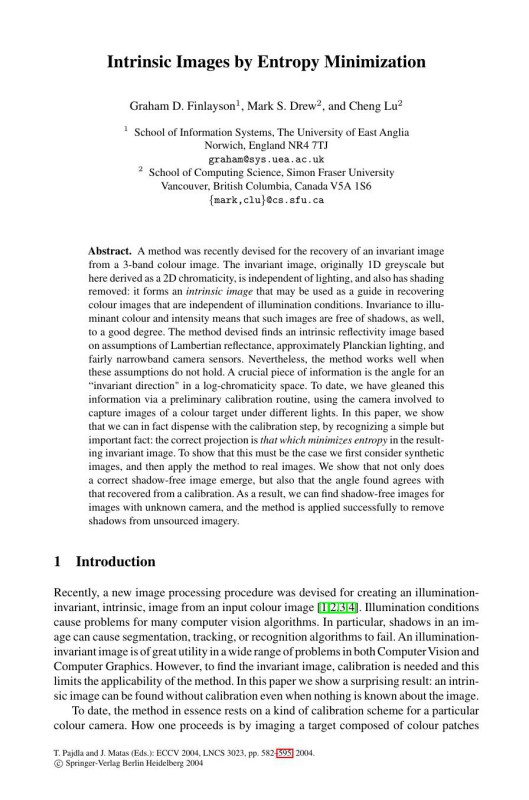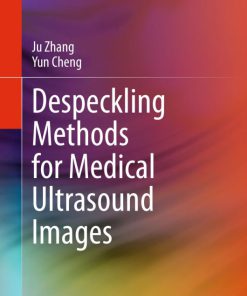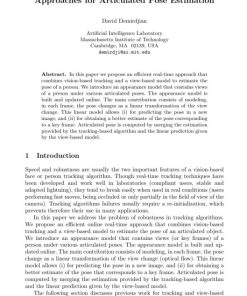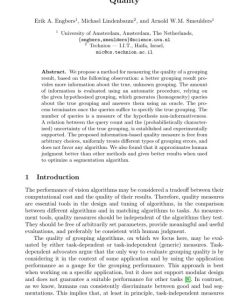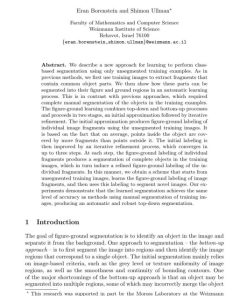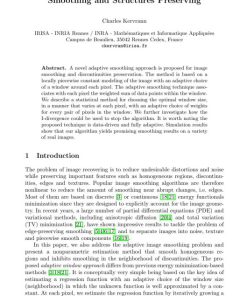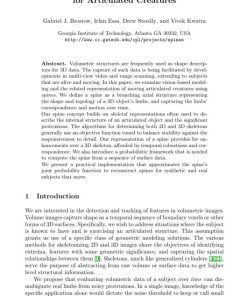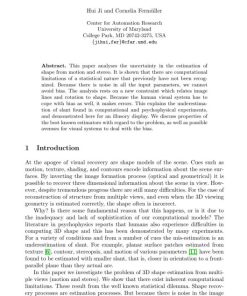Intrinsic Images by Entropy Minimization 1st edition by Graham Finlayson, Mark Drew, Cheng Lu ISBN 3540219828 9783540219828
$50.00 Original price was: $50.00.$25.00Current price is: $25.00.
Authors:Graham D. Finlayson, Mark S. Drew; Cheng Lu , Tags:Computer Vision – ECCV 2004 , Author sort:Graham D. Finlayson, Mark S. Drew & Lu, Cheng , Languages:Languages:eng , Published:Published:Mar 2004
Intrinsic Images by Entropy Minimization 1st edition by Graham D. Finlayson, Mark S. Drew, Cheng Lu – Ebook PDF Instant Download/Delivery. 3540219828, 978-3540219828
Full download Intrinsic Images by Entropy Minimization 1st Edition after payment
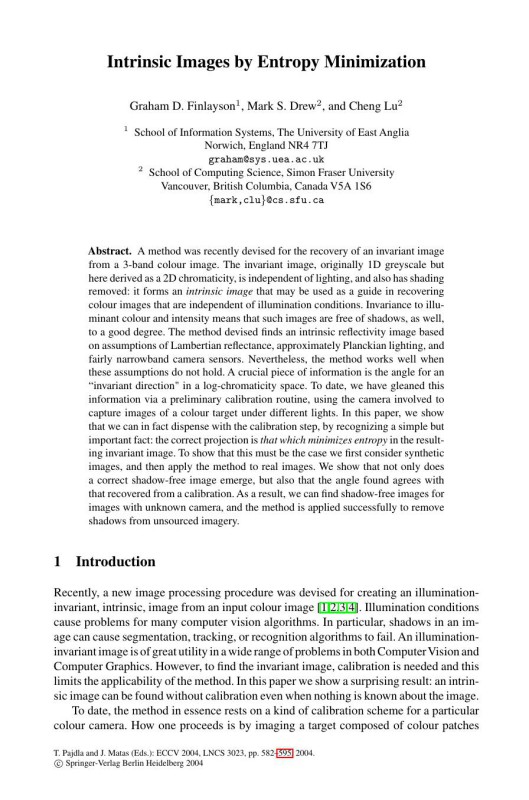
Product details:
ISBN 10: 3540219828
ISBN 13: 978-3540219828
Author: Graham D. Finlayson, Mark S. Drew, Cheng Lu
A method was recently devised for the recovery of an invariant image from a 3-band colour image. The invariant image, originally 1D greyscale but here derived as a 2D chromaticity, is independent of lighting, and also has shading removed: it forms an intrinsic image that may be used as a guide in recovering colour images that are independent of illumination conditions. Invariance to illuminant colour and intensity means that such images are free of shadows, as well, to a good degree. The method devised finds an intrinsic reflectivity image based on assumptions of Lambertian reflectance, approximately Planckian lighting, and fairly narrowband camera sensors. Nevertheless, the method works well when these assumptions do not hold. A crucial piece of information is the angle for an “invariant direction” in a log-chromaticity space. To date, we have gleaned this information via a preliminary calibration routine, using the camera involved to capture images of a colour target under different lights. In this paper, we show that we can in fact dispense with the calibration step, by recognizing a simple but important fact: the correct projection is that which minimizes entropy in the resulting invariant image. To show that this must be the case we first consider synthetic images, and then apply the method to real images. We show that not only does a correct shadow-free image emerge, but also that the angle found agrees with that recovered from a calibration. As a result, we can find shadow-free images for images with unknown camera, and the method is applied successfully to remove shadows from unsourced imagery.
Intrinsic Images by Entropy Minimization 1st Table of contents:
-
Introduction
- 1.1 Motivation for Intrinsic Image Decomposition
- 1.2 The Role of Entropy in Image Processing
- 1.3 Overview of Existing Methods for Intrinsic Image Estimation
- 1.4 Key Challenges in Intrinsic Image Decomposition
- 1.5 Contributions of the Paper
- 1.6 Structure of the Paper
-
Related Work
- 2.1 Early Approaches to Intrinsic Image Decomposition
- 2.2 Optimization Techniques in Intrinsic Image Extraction
- 2.3 Entropy-Based Methods in Image Processing
- 2.4 Recent Advances in Reflectance and Shading Separation
- 2.5 Limitations of Current Methods and the Need for Entropy Minimization
-
Problem Formulation
- 3.1 Definition of Intrinsic Image Decomposition
- 3.2 The Reflectance and Shading Models
- 3.3 The Concept of Entropy in the Context of Image Decomposition
- 3.4 Objective Function for Entropy Minimization
- 3.5 Assumptions and Constraints in the Proposed Method
-
Entropy Minimization Framework
- 4.1 Overview of Entropy and its Significance in Image Processing
- 4.2 Formulation of the Entropy Minimization Problem
- 4.3 Probabilistic Interpretation of Intrinsic Image Components
- 4.4 Entropy Regularization and its Role in Image Decomposition
- 4.5 Optimization Strategies for Entropy Minimization
- 4.6 Computational Challenges and Solutions
-
Methodology for Intrinsic Image Decomposition
- 5.1 Initial Image Segmentation and Preprocessing
- 5.2 Estimating Reflectance and Shading via Entropy Minimization
- 5.3 Handling Noise and Inconsistencies in the Image
- 5.4 Incorporating Edge and Texture Information in the Decomposition
- 5.5 Constraints and Penalties in the Optimization Problem
- 5.6 Final Steps in Reflectance and Shading Separation
-
Algorithm Design and Implementation
- 6.1 Step-by-Step Algorithm for Entropy Minimization in Intrinsic Image Decomposition
- 6.2 Iterative Optimization Process for Reflectance and Shading Estimation
- 6.3 Computational Considerations and Efficiency
- 6.4 Parallelization or Approximation Techniques for Large-Scale Images
- 6.5 Implementation Details and Code Availability
-
Experimental Setup and Evaluation
- 7.1 Datasets for Intrinsic Image Decomposition
- 7.2 Evaluation Metrics (e.g., Reflectance Accuracy, Shading Estimation)
- 7.3 Baseline Methods and Comparison Criteria
- 7.4 Experimental Protocols and Testing Scenarios
- 7.5 Performance Analysis for Various Image Types and Conditions
-
Results and Discussion
- 8.1 Quantitative Results of Intrinsic Image Decomposition
- 8.2 Visual Results: Comparison with Ground Truth and Existing Methods
- 8.3 Analysis of Reflectance and Shading Estimation Accuracy
- 8.4 Comparison of Entropy Minimization with Other Optimization Approaches
- 8.5 Impact of Entropy Minimization on Handling Shadows, Specularity, and Textures
- 8.6 Limitations and Challenges in Practical Applications
-
Applications of Intrinsic Image Decomposition
- 9.1 Computer Graphics and Rendering
- 9.2 Image-Based Lighting and Relighting
- 9.3 Object Recognition and Scene Understanding
- 9.4 Image Editing and Enhancement
- 9.5 Other Applications in Augmented Reality and Vision-Based Systems
-
Challenges and Future Directions
- 10.1 Addressing Real-World Complexity in Images (Lighting Variations, Complex Scenes)
- 10.2 Handling Multiple Light Sources and Dynamic Environments
- 10.3 Improving Efficiency for Real-Time Processing
- 10.4 Incorporating Deep Learning with Entropy Minimization for Better Performance
- 10.5 Future Research Directions in Intrinsic Image Decomposition
- Conclusion
- 11.1 Summary of Contributions and Findings
- 11.2 Practical Implications of the Proposed Method
- 11.3 Limitations of the Current Approach
- 11.4 Final Remarks and Vision for Future Work
People also search for Intrinsic Images by Entropy Minimization 1st :
recovering intrinsic images from a single image
deriving intrinsic images from image sequences
user assisted intrinsic images
coherent intrinsic images from photo collections
intrinsic images by entropy minimization
You may also like…
eBook PDF
Learning to Segment 1st edition by Eran Borenstein, Shimon Ullman ISBN 3540219828 9783540219828
eBook PDF
Bias in Shape Estimation 1st edition by Hui Ji, Cornelia Fermuller ISBN 3540219828 9783540219828

